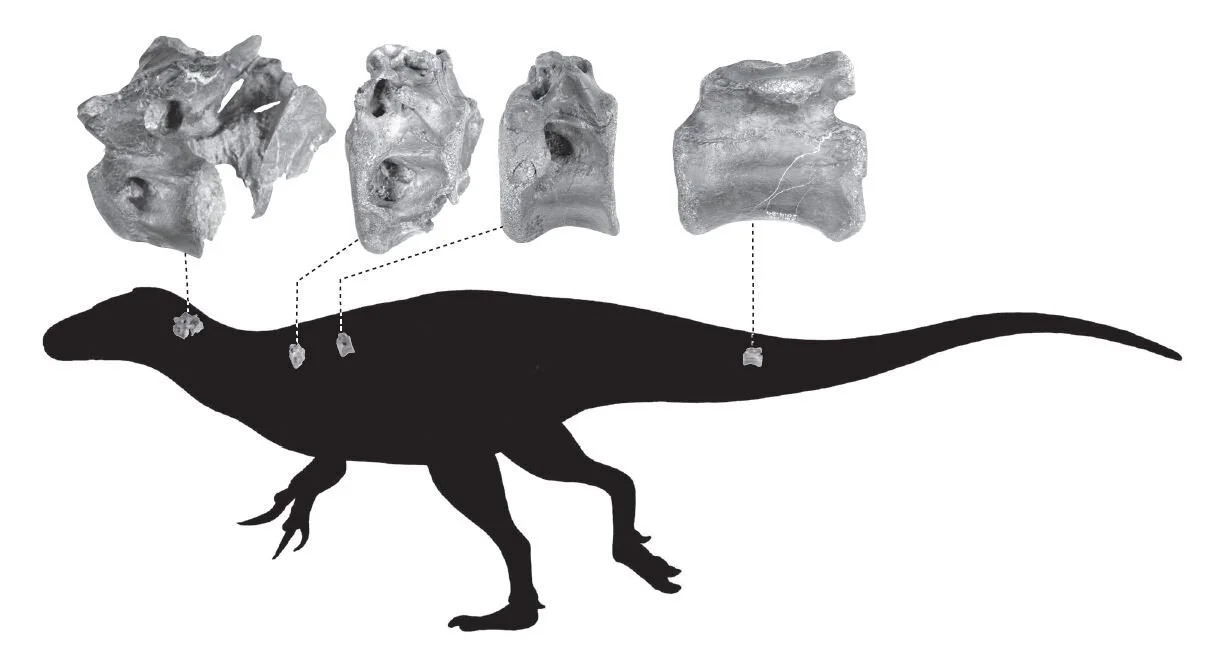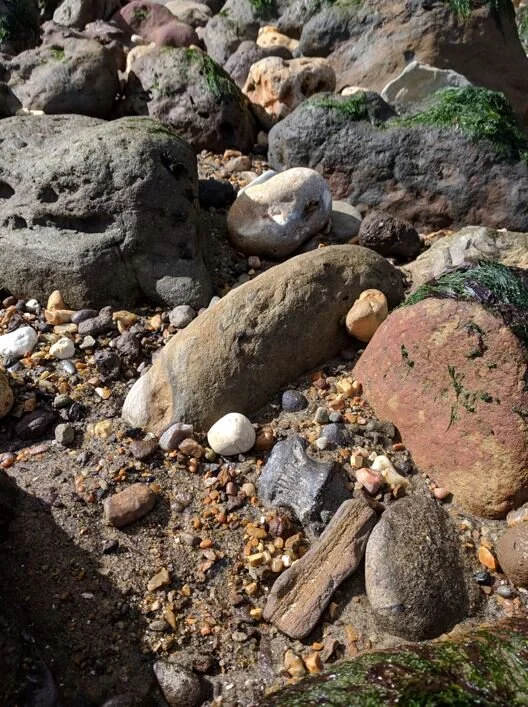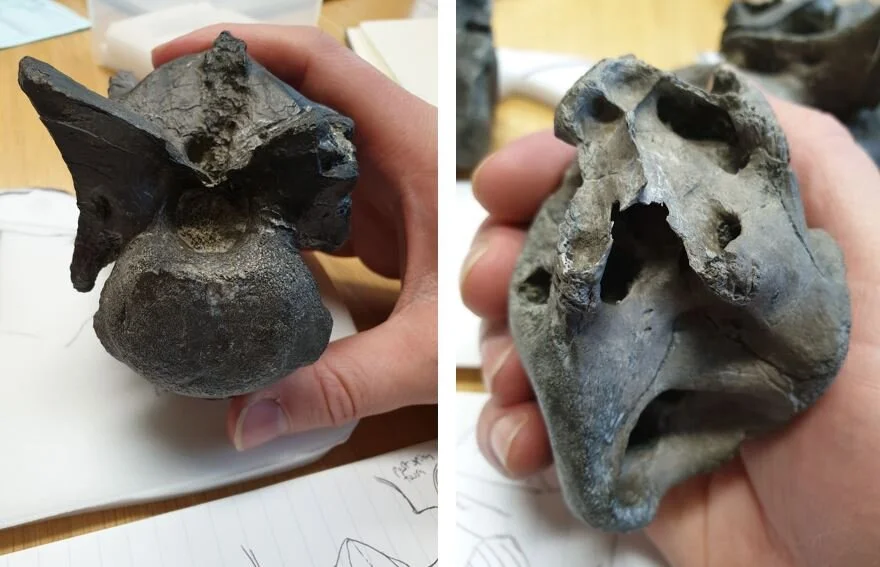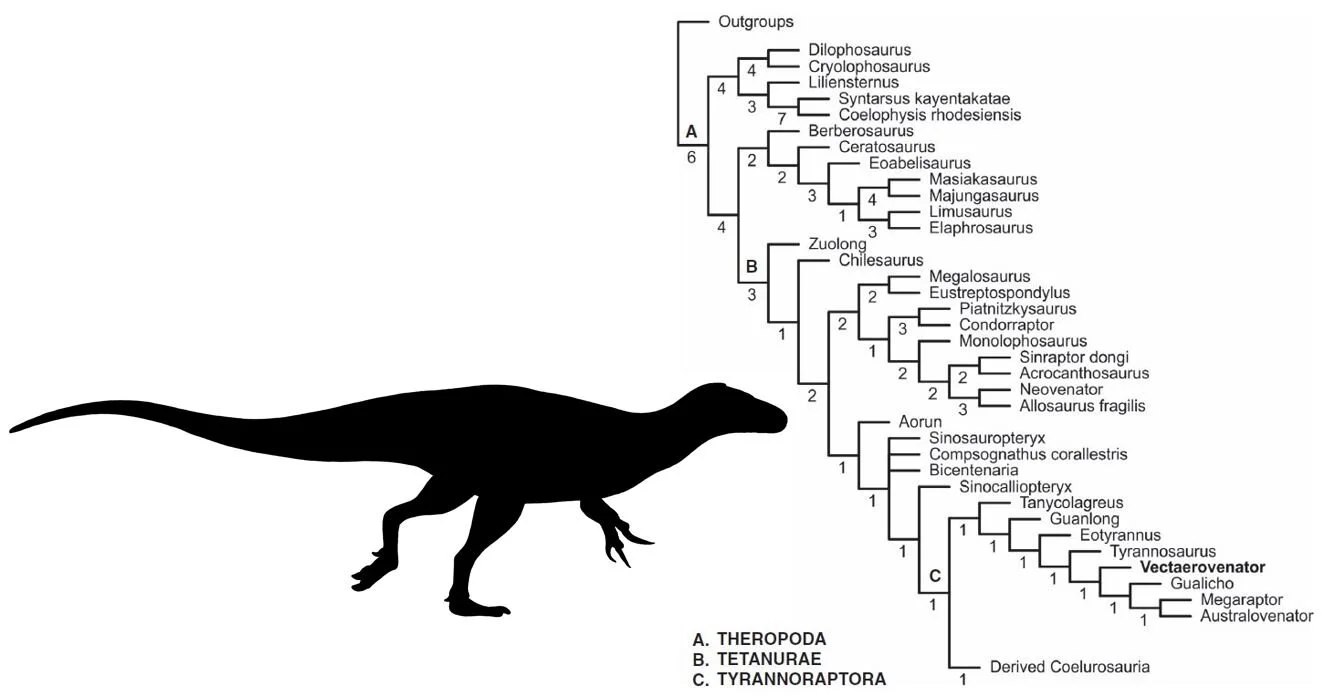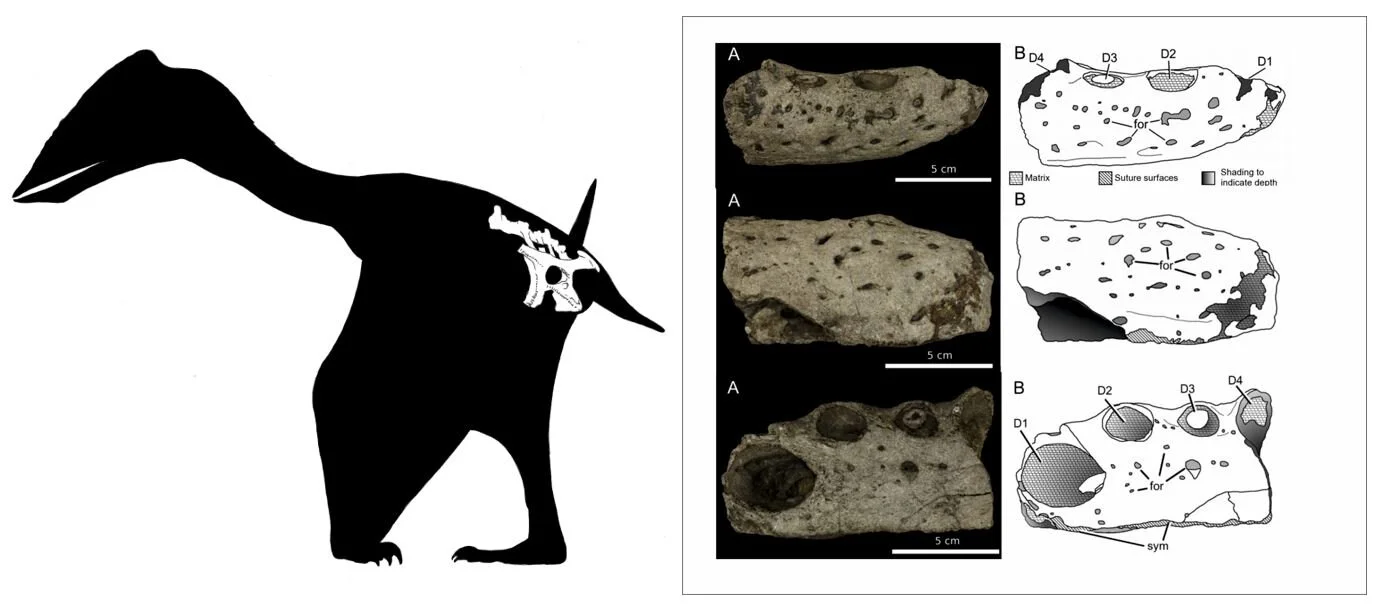As a regular reader here, you might be familiar with the idea that we’re currently in a Golden Age of dinosaur discovery. More fossil dinosaurs are being discovered, monthly and annually, than at any other point in history, and numerous locations worldwide – even those considered well explored and well understood scientifically – continue to yield new species. Yes, new dinosaurs are found in countries like Malawi, Ecuador and Tanzania, and in Antarctica, but new dinosaurs are also found in the USA, France, Spain and the UK. This week sees the publication of yet another new dinosaur from England. I’m writing about it because I’m one of its describers.
Caption: the corpse of a deceased Vectaerovenator floats in the shallow Early Cretaceous sea covering what’s now southern England. Ammonites and platypterygiine ichthyosaurs are nearby. Image (c) Trudie Wilson
I’m referring to Vectaerovenator inopinatus Barker et al., 2020 from the Ferruginous Sandstone Formation of the Greensand Group of the Isle of Wight, published in a new OPEN ACCESS paper in Papers in Palaeontology (Barker et al. 2020). The full authorship is Chris Barker, myself, Claire Clarkin, Paul Farrell, Gabi Hullman, James Lockyer, Philipp Schneider, Robin Ward and Neil Gostling… which is a lot of authors for a species represented by just a few bones, but there you go.
Indeed, Vectaerovenator is known only from four vertebrae*. One is certainly from the neck and has the characteristic opisthocoelous form present in the neck vertebrae of several theropod groups; this means that there’s a convex condyle at the front, and a concave cotyle at the rear. Two are from the dorsal part of the series, and one is from the tail. These vertebrae were discovered at different times by three different collectors (Paul Farrell, James Lockyer and Robin Ward) and I’m pleased to report that all were donated to the collections of Dinosaur Isle at Sandown, the Isle of Wight’s primary palaeontological repository. In fact, our paper represents an excellent example of the ideal relationship that can, and should, arise between fossil collectors, museums and academic researchers. Well done to everyone involved; we hope for more of this sort of thing in the future.
* Spoiler: some additional bits and pieces have turned up since the paper was published. We hope that these eventually make their way to a museum collection.
Caption: silhouette of Vectaerovenator showing the approximate position of the elements described in our paper. I deliberately made the animal look like a generic tetanuran theropod that isn’t referable to any specific lineage; read on. Image: Barker et al. (2020).
Despite the Vectaerovenator bones being discovered on different occasions, we’re confident that they all belong to the same species and even the same individual. How so?
Firstly, dinosaur remains are very rare at this locality (Knock Cliff, Shanklin, on the south-east coast of the Isle of Wight): it’s not as if there are the remains of numerous specimens and taxa kicking around there. Secondly, the bones were all discovered across the same short time interval (respectively, in the March, May and September of 2019). Given their fragility (and geographical proximity), this makes it likely that they represent a set of associated bones that were exposed, and then scattered and moved around the beach by wave action, at the same time. Thirdly, they’re all anatomically homogenous: they all look alike, share features which aren’t present in other theropods, and are consistent in size. And fourthly, they come from the same specific geological bed as they have identical adhering matrix, this most likely being that of the New Walpen (XIII) Member of the Ferruginous Sands Formation (Barker et al. 2020).
Caption: the Vectaerovenator bones were found on the beach, as shown here in this photo by James Lockyer. You should be able to see the vertebra - the grey block with a striated texture - in the middle of the photo’s lower half.
Anatomy and the need for a name. Numerous anatomical details show that this new dinosaur is a theropod (Barker et al. 2020), and what struck us immediately about the vertebrae is that they’re incredibly pneumatic (most theropods – and their distant cousins the sauropods – possessed air-filled sacs in their vertebrae. These were connected by tubes to the lungs and formed part of a complex respiratory system). A surprising number of pneumatic pockets, cavities and hollows are present on and in both the neural arch (the structure on the top of the vertebra; it houses the spinal cord) and centrum (the main body of the vertebra) of the Knock Cliff theropod.
Caption: these images, showing three of the four described Vectaerovenator vertebrae, show how impressively pneumatic this dinosaur was. The bone at far left is the cervical vertebra IWCMS 2020.407; the other two are the anterior dorsal vertebrae IWCMS 2019.84 and IWCMS 2020.400. All are shown in left lateral view.
The bony struts and shelves that form the boundaries to these pneumatic structures have a unique configuration in our new animal and mean that the Knock Cliff remains are diagnostic. In other words, they’re unique, and can be reliably distinguished from those of other theropods. If your fossil is diagnostic, it’s worthy of a name, and the one we chose – Vectaerovenator inopinatus – refers to the taxon’s Isle of Wight provenance, its extremely pneumatic nature, and its unexpected discovery in the Isle of Wight Greensand (most Isle of Wight dinosaurs are from the older rocks of the Wealden Supergoup). The name translates roughly as ‘unexpected Isle of Wight air-filled hunter’ (Barker et al. 2020).
The Vectaerovenator bones are ‘mid-sized’ as theropod bones go, neither being small nor especially big. Their lengths range from about 5.2 to nearly 8 cm, sizes that are about consistent with a total length of around 4 metres. However, the neurocentral suture are not fused and are still obvious externally, so this animal hadn’t reached maturity and likely had a bit of growing still to do. An adult was, therefore, likely somewhat larger.
Caption: Vectaerovenator bones in my hand, which should give you a good idea of their exact size. Images: Darren Naish.
What sort of theropod is Vectaerovenator? Even before we’d named the Knock Cliff theropod or finished describing it, we were sure it was a tetanuran (Tetanurae = the theropod clade that includes everything closer to birds than to Ceratosaurus. In other words: megalosaurs, spinosaurs, allosaurs and coelurosaurs). Beyond that, however, we were seeing features that indicated a possible allosauroid identity (specifically, a carcharodontosaurian one), or maybe a coelurosaurian one. For a while, we played with the idea that it might be a member of Megaraptora, the controversial Gondwanan theropod clade which is argued to belong to Carcharodontosauria by some experts, and to Coelurosauria or even Tyrannosauroidea by others. Alas, this megaraptoran idea is unlikely to be correct, since Vectaerovenator differs in several details from the members of that group.
Caption: we recovered Vectaerovenator as a potential tyrannosauroid… buuuut we’re not very confident that it’s right. Image: Barker et al. (2020).
We included the specimen in a phylogenetic analysis to see which position it might occupy. It was always recovered as a tetanuran, and specifically as a member of Tyrannosauroidea close to Megaraptora! However, we aren’t confident about this result, since the traits which support it are widely distributed within tetanurans (Barker et al. 2020). Furthermore, when we included it within constrained analyses (essentially, analyses where the number of potential possibilities is reduced) its position proved more unstable, and it only took a few steps for it to move over to Megalosauroidea or Allosauroidea (Barker et al. 2020). The conclusion? We haven’t nailed down its affinities with confidence, and – for now – it might be that we can’t. It’s probably best to regard it as an indeterminate tetanuran, and the fact that it’s anatomically unusual and from a poorly sampled part of the geological record could mean that it belongs to a new, previously unsampled tetanuran lineage.
Caption: obviously, it isn’t possible to determine the life appearance of Vectaerovenator at this stage. But it would have looked something like one of these animals. They represent (left to right) Tyrannosauroidea, Megalosauroidea and Allosauroidea. Images: Darren Naish.
Ecology, biology and lifestyle. The geological setting of Vectaerovenator is interesting. The Ferruginous Sands Formation (part of the Lower Greensand Group) is Lower Cretaceous, and specifically Aptian. More specifically still, Vectaerovenator is from the New Walpen Member of the Ferruginous Sands Formation and thus dates to the middle Late Aptian. This puts it at about 116 million years in age and makes Vectaerovenator the youngest British theropod recorded so far… excepting some indeterminate teeth (Barrett et al. 2010), some indeterminate, probable coelurosaur fragments (Galton & Martin 2002) and, of course, numerous Cenozoic birds. My take on British dinosaurs (and, I’m sure, that of my mostly UK-based colleagues) is virtually always Anglocentric, but in this case the young age of Vectaerovenator is significant for Europe as a whole, since Late Aptian European theropods are rare: assorted theropod fragments are known from the Aptian of Europe but none are good enough to warrant naming (Pereda-Suberbiola et al. 2012).
Of further interest is that the Greensand Group is entirely marine, so Vectaerovenator’s remains were buried and fossilised in a marine setting. Does this tell us anything specific about this animal’s ecology or biology? The possibility exists that Vectaerovenator had some special link to the marine environment. Maybe it habitually foraged along shorelines or in shallow water; maybe, even, it was amphibious and caught prey while swimming. But we assume for now that its remains – perhaps the whole of the animal – were washed out to sea by a river, or possibly represent an individual pulled into the marine realm by a large predator (Benton et al. 1995, Barker et al. 2020). The remains of land-living dinosaurs have often been discovered in marine rocks, so this is far from a first.
Caption: readers with good memories will recall the other Greensand fossils discussed here in the past, namely the small azhdarchoid pterosaur Vectidraco and the Shanklin croc. Images: Naish et al. (2013); Young et al. (2014).
So – what next? One thing we have planned is to CT-scan Vectaerovenator’s bones: the results will likely provide further insight on this animal’s anatomy. But, for now, that’s about it. Vectaerovenator is significant in adding to our knowledge of both Aptian-aged theropods and the Aptian fauna of western Europe as a whole (other Isle of Wight Greensand fossils I’ve worked on include the pterosaur Vectidraco and the as-yet-unnamed Shanklin croc; Naish et al. 2013, Young et al. 2014), but – obviously – it’s poorly known. We hope that more material will, in time, add to what we know of this very interesting animal. And much more in due to be published on Isle of Wight theropods soon, stay tuned for some amazing news.
For previous TetZoo articles on British dinosaurs and Aptian fossils relevant to this article, see…
The world’s most amazing sauropod, November 2007
Oh no, not another new Wealden theropod!, June 2009
Daisy’s Isle of Wight Dragon and why China has what Europe does not, March 2013
‘Shanklin croc' and the dawn of the tethysuchian radiation, October 2014
10 Long, Happy Years of Xenoposeidon, November 2017
Theropod Dinosaurs of the English Wealden, Some Questions (Part 1), March 2020
Refs - -
Benton, M. J., Martill, D. M. & Taylor, M. A. 1995. The first Lower Jurassic dinosaur from Scotland: limb bone of a ceratosaur theropod from Skye. Scottish Journal of Geology 31, 177–182.
Barrett, P., Benson, R. & Upchurch, P. 2010. Dinosaurs of Dorset: Part II, the sauropod dinosaurs (Saurischia, Sauropoda) with additional comments on te theropods. Proceedings of the Dorset Natural History and Archaeological Society 131, 113-126.
Galton, P. M. & Martin, L. D. 2002. Postcranial anatomy and systematics of Enaliornis Seeley, 1876, a foot-propelled diving bird (Aves: Ornithurae: Hesperornithiformes) from the Early Cretaceous of England. Revue de Paléobiologie 21, 489-538.
Pereda-Suberbiola, X., Ruiz-Omeñaca, J. I., Canudo, J. L., Torcida, F. & Sanz, J. L. 2012. Dinosaur faunas from the Early Cretaceous (Valanginian-Albian) of Spain. In Godefroit, P. (ed.) Bernissart Dinosaurs and Early Cretaceous Terrestrial Ecosystem. Bloomington: Indiana University Press, pp.


